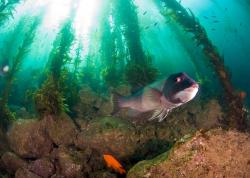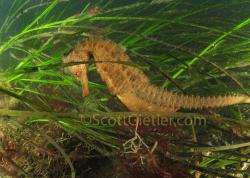More Ideas for Underwater Compositions
1) Diagonal lines
One of the strongest compositions, and one of my favorites involved diagonal lines. Let's look at some examples:
- Diagonal subject, parallel to the camera

Long fish or shrimp make great diagonal lines in photos. This is a "2-D" diagonal composition, because the entire subject is in focus. Robust ghost pipefish, Anilao, Phillipines.
Diagonal subject, three dimensional underwater compostion
This can be a difficult composition to attain, but it is one of the most dramatic. The entire body of the subject is placed from one lower corner to the opposite diagonal corner. Different depth of fields will give different results. This composition works great for macro & supermacro, especially for long subjects such as shrimp, pipefish, etc. Getting the subject perfectly placed can take time.

Flutemouth, taken in Bali. F13, 1/200th, ISO 200, 60mm lens +1.4x tele. This "3d" diagonal view is very hard to compose and takes lots of practise, but the results are worth it. You must carefully compose until the rear of the subject is placed in the upper corner, out of focus. This works well for long subjects.

F25, 1/200th. Photo by Jeff de Guzman, uncropped. Sawblade shrimp, Anilao, Phillipines

Notice how the diagonal goes nicely from corner to corner. Photo by Todd Winner. Oil Rigs, california

Here's a nice composition - diagonal line, shooting upwards, black background. Photo by Rand McMeins.
2) Fill the frame
Filling the frame with a subject is a common compositional theme, and adds a dramatic touch to the photo.

This cuttlefish looks more dramatic when he fills the entire frame. Flamboyant cuttlefish, Anilao, Phillipines.

Filling the frame with the seahorse gives it a nice perspective. D300, 105mm lens, Lembeh strait, Indonesia. F4, 1/100th, ISO 1500, lit by my dive light.

Fill the frame combined with an out of focus background can work very well. Red octopus, Redondo beach, California. F13, 1/250th, ISO 200, D300 + 60mm lens + 1.4x tele.
For many more examples of fill the frame, please see the artistic composition section.
Or read our complete fill the frame article.
3) Colors & color combinations
Use of color underwater: People love photographs filled with bright colors, especially reds, oranges, and yellows.

Field of featherdusters - reds, oranges, yellows. El segundo, California
Red - this is the best color to shoot! get very close for the best reds
Orange or yellow - these are also great colors. Try to get a blue background with these colors if you can.
Green - green is the color of nature. Backgrounds look great with green in them. Green also works well with red, pink, or orange.
Use complimentary colors. Yellow against blue, red against green works well.


Bright colors from Ensenada, baja, Mexico.

When I saw these reds and yellows together, I took extra time to try to get a shot of this skittish goby. F11, 1/320th, ISO 250. Catalina Island, California.
4) Take the subject to the edge

Photo by Cal Mero. F8, 1/2000th, Oly SP350. Notice how the subject extends just to the edges of the frame. A nice composition.
5) Negative space (Having a good background).
- finding a complimentary color
- shooting in front of a sea fan or coral
- blurring the background with a large aperture
- isolating the subject with a black background

I thought the soft corals would make a nice background for this fish. F10, 1/200th, ISO 320. Anilao, Phillipines

Here the background is nicely blurred, emphasizing the goby. F11, 1/250th, ISO 200. Anilao, Phillipines. Here's an article on "face-on" macro underwater composition.
6) Black background
Please see the section on black backgrounds underwater.
7) Leading lines
In a composition featuring "leading lines", all lines in the composition lead to the main point of interest. The viewer's eye follows the lines to a point of focus, hence the expression leading lines.

In this photo, your eyes are led up the lines of the rigs structure to an interesting area of reflections on the surface. Oil rigs, southern california.

A nice examples of "lieading lines" leading up to the subject. D300, F16, 1/250th, ISO 200. 105mm lens with a Subsee wet diopter. Photo by Keri Wilk. Goby shot in Bali, Indonesia. Compositions like this are usually quick tricky to get right.

Kelp at Catalina Island. Your eyes follow the lines of the kelp, leading up to the stalk. F9, 1/320th, D300 + 60mm + 1.4x tele
8) S-curve
This macro photo nicely demostrates an "s-curve" moving through the photo. depth of field is used nicely to bring emphasis to the face of the subject. This type of composition takes very careful placement of the camera.

Island kelpfish, Photo by Kevin Lee, 1st place winner in LAUPS International contest. Catalina, california.

This nudibranch shows an S-curve pattern in the photo. Near los angeles, California.

Yet another beautiful s-curve. Photo by Cal Mero. F8, 1/800th, Oly SP350. The diagonal layout and taking the subject to the edges of the frame both enhance this fine composition.
9) Golden spiral

Moon snail, redondo beach, California. A perfect example of a golden spiral, this photo also nicely shows texture and even lighting.

I think the curvature of this warbonett works nicely. The rule of thirds worked nicely here also, with the fish's eyes lying near an intersection. Taken in British columbia, Canada by Rand McMeins.
10) Fish Portraits
This section has been moved to the Fish Photography page
More reading:

RECOMMENDED ARTICLES
SUPPORT THE UNDERWATER PHOTOGRAPHY GUIDE:
The Best Service & Prices on u/w Photo Gear
 Visit Bluewater Photo & Video for all your underwater photography and video gear. Click, or call the team at (310) 633-5052 for expert advice!
Visit Bluewater Photo & Video for all your underwater photography and video gear. Click, or call the team at (310) 633-5052 for expert advice!
The Best Pricing, Service & Expert Advice to Book your Dive Trips
 Bluewater Travel is your full-service scuba travel agency. Let our expert advisers plan and book your next dive vacation. Run by divers, for divers.
Bluewater Travel is your full-service scuba travel agency. Let our expert advisers plan and book your next dive vacation. Run by divers, for divers.





























